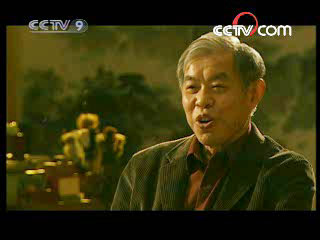------Program code: DO-080723-01033 (what's this?)
Source: CCTV.com
07-23-2008 08:43
As the main materials used in Chinese painting, water and ink are given various meanings in the hands of an artist. An artist who can combine water and ink perfectly, can accomplish a large painting without washing his brush. One such artist is the veteran landscape painter Lu Xingtang, at the Jiangsu Chinese Painting Institute. He is a national first-class artist, and a member of the China Artists Association.
 |
Lu Xingtang was born in 1938 to a family of artists in Fenghuang Town, Changshu in Jiangsu Province. Changshu is a town that has historically produced numerous great writers. His father, Lu Zhongcai, was a famous member of the Yushan school of artists. Influenced by his father, Lu Xingtang became closely involved with painting at an early age. The beautiful scenery of south China would become a theme of his painting throughout his life.
 |
After graduating from senior high school, 19-year-old Lu Xingtang met the first obstacle on his path to an artistic career. Surprisingly, the obstacle was his parents.
However, Lu Xingtang refused to be persuaded by his parents. That summer, despite their protests, he went to Suzhou, taking only a box, a quilt and some matting.
Lu Xingtang found work at the Suzhou Culture and Technique Factory as a landscape painter. He was soon the head of the portrait and landscape painting team. This was the start of a lifelong devotion to Chinese landscape painting.
It was at that time that Lu Xingtang developed an interest in the landscape paintings of Fu Baoshi. Fu Baoshi wasn’t recognized in Suzhou’s painting circles, which were dominated by industrial artists. But Lu Xingtang preferred his painting style. He took every opportunity to appreciate and study Fu Baoshi’s works.
In the course of reading Fu Baoshi’s paintings, he had the satisfaction of feeling he was learning something. But he never expected that within a year, he’d have the chance to learn from Fu Baoshi in person.
1958 was the year when the Jiangsu Industrial Arts Institute was due to be established. 21-year-old Lu Xingtang was sent to Nanjing to work at the Jiangsu Chinese Painting Institute, as an assistant to the senior artists. There he met his idol, the landscape painting master Fu Baoshi. He was also able to work together with other masters such as Qian Songyan, Ya Ming, Song Wenzhi and Wei Zixi. Gradually, the diligent young man won their respect.
The following day, Lu Xingtang arrived very early at No.6, Fuhougang.
The experience of watching Fu Baoshi painting would influence Lu Xingtang for the rest of his career. In the following decades, Lu Xingtang’s painting style would become both unconstrained and circumspective.
Though a small painting, “Water Conservancy Project at Dujiangyan” contains many elements; the dam, the expressway, vehicles and people. The richness of the content creates an impression of unlimited space.
